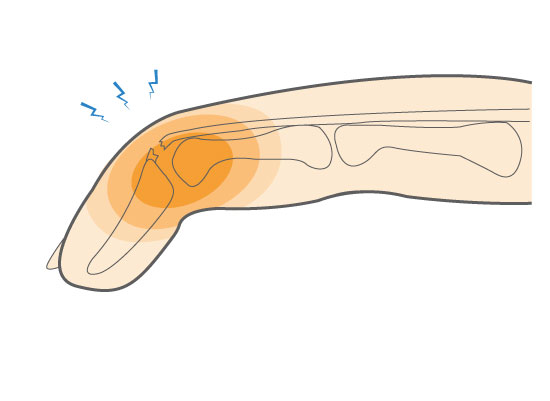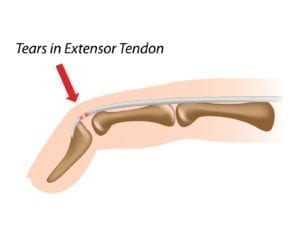Mallet finger refers to an injury to the extensor tendon, fibrous tissue that connects muscle to bone and straightens the finger’s end joint. Sometimes referred to as “baseball finger,” the injury can occur when a ball or some other object hits the tip of the finger, damaging the tendon. As a result, the finger can’t straighten and looks deformed. A mallet finger can be painful and requires medical attention.
Mallet Finger Causes, Symptoms & Treatment Options
Mallet finger refers to an injury to the extensor tendon, fibrous tissue that connects muscle to bone and straightens the finger’s end joint. Sometimes referred to as “baseball finger,” the injury can occur when a ball or some other object hits the tip of the finger, damaging the tendon. As a result, the finger can’t straighten and looks deformed. A mallet finger can be painful and requires medical attention
Overview
Overview

What causes Mallet Finger?
Mallet finger often happens after a finger gets jammed, forcing the fingertip to bend beyond its normal range, which damages the tendon. This injury commonly occurs when playing ball sports, but can happen due to any trauma to the finger joint. Sometimes people don’t recall the moment of injury. Mallet finger is most common in these sports:
• Basketball
• Baseball
• Football
• Rugby

Symptoms
When you have mallet finger, your fingertip droops noticeably and can’t straighten on its own. Pain may be felt but often is not one of the symptoms, especially if the finger is not also fractured. Other common symptoms include:
• Bruising
• Swelling
• Blood beneath the nail
When to see a doctor
If you have symptoms of a mallet finger, see your doctor within a week of your injury or onset of symptoms. Prompt treatment will help ensure your finger regains full function. Seek immediate treatment if you have blood underneath your nail, as this could put you at risk for an infection.
Your doctor will ask questions about your injury, as well as your medical history and physical activity. During the physical exam, he or she may ask if you can straighten your finger. Your doctor may also order x-rays to determine whether any bones are broken or pulled out of alignment.
Non-operative treatment
Most mallet finger injuries are successfully treated without surgery. Treatment typically involves wearing a splint that keeps your fingertip extended until the tendon has time to heal. Usually the splint must be worn full time for about eight weeks. Applying cold packs and taking nonsteroidal anti-inflammatory (NSAID) medication like ibuprofen can help relieve pain. Your doctor may recommend exercises to keep your finger from becoming stiff.
You can also try these exercises at home:
Surgical Treatment
In rare cases, when there is a bone fragment due to a fracture or the finger joint is out of alignment, your doctor may recommend surgery. Your surgeon will repair the fracture using pins or screws to hold it in place while it heals.
Recovery
Athletes should follow their doctor’s guidance and wear a splint for the recommended time frame. While some sports can be played wearing a splint, for others it can be difficult. Athletes should consult with their doctor on when it’s safe to return to play. Though a full recovery time can take several weeks, with proper diagnosis and treatment, athletes can expect to fully recover from mallet finger.

